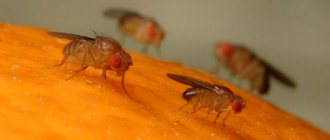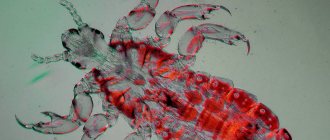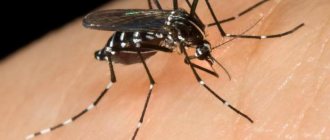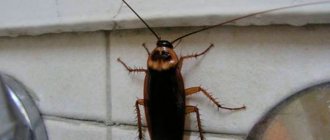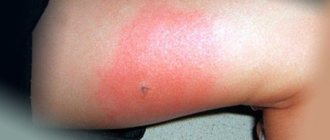What do a gadfly and its larvae look like?
Gadflies live in almost every corner of the planet; in total there are more than 150 species of insects. In our country, 60 varieties are registered. Usually, gadflies lay their larvae in the body of animals, less often they get under the skin of a person. Dermatobia Hominis - the “human gadfly” lives in the tropics (Mexico, South America, Argentina). In the temperate climate of Russia, Ukraine and the countries of the former USSR, the insect has not been observed.
The adult is a special species of fly measuring up to 20 mm. Dermatobia Hominis looks like a small bumblebee: a shaggy body and a bright orange color. The gadfly has a rather large head with pronounced large eyes, a blue abdomen, and small transparent wings.
Insects living in our latitudes usually have a calmer color: dark brown or coal-black, gray-blue. They prefer livestock as a host, but it happens that when they bite, they also infect humans.
The adult does not feed; the supply of nutrients obtained during the larval development stage is enough for the entire life cycle.
The larva after birth is very small. During the phase, it grows several times, reaching 2 cm. Its body has an oblong teardrop shape. Special hook hairs allow it to attach to the skin of animals or humans.
One adult female can reproduce up to 650 eggs, but only 20% are viable.
A species of dangerous gadfly that lives in southern countries.
Lifestyle and nutrition
Unlike the gadfly, horseflies are not parasites. This insect is classified as a midge, as it feeds on the blood of mammals. The flight of horse flies begins when the air temperature warms up to +15 °C. In central Russia this is approximately the twentieth of May. In the south - a little earlier.
As we said above, horseflies feel good in forests, fields, steppes, as well as in deserts and mountainous areas. These blood-sucking flies like to hunt closer to bodies of water, because there is moisture necessary for their life. By the way, horsefly larvae of most species develop in water. Adults spend almost their entire lives in flight.
These insects, unlike mosquitoes and midges, love sunny and hot weather, so they are often active during the daytime on summer and warm days. These flies perk up sharply before rain, but in bad weather and wind they do not fly or hunt. The exception is horse flies, which can attack even in light rainfall.
Many people wrongly believe that horseflies feed only on blood. The fact is that the males of all these flying insects are “vegetarians”. They eat plant pollen, flower nectar, worm secretions, aphids, etc. Only fertilized female horseflies bite and drink blood. They need this liquid for procreation, and more precisely, for the development of eggs.
Moreover, in one meal, each female can suck up to 200 mg. As for unfertilized females, they easily tolerate the lack of protein food and are content with a plant-based menu.
During flight, horseflies can reach speeds of up to 60 km/h. This is comparable to the speed of a car moving through the city. Moreover, the average flight range of this insect is 2-4 km.
How does a gadfly larva enter the human body?
The gadfly larva can enter the human body in several ways:
- The female lays eggs on the abdomen of blood-sucking insects (mosquitoes, ticks). When a person is bitten by intermediary insects, the eggs land on the person's body. When warmed up, they burst and larvae emerge from them, which get under the skin. The introduction of parasites is practically not noticeable.
- When a human is bitten directly by the female gadfly itself, the larvae enter the wound, after which they fully develop as parasites in the person.
- Hypodermatosis is a disease associated with these parasites. In this case, the larva is acquired tactilely from cattle. It is the countryside and farms in our latitudes that can be considered a potential site of infection. Parasites get under the skin, and they can move along the body, leaving characteristic traces. The larvae usually penetrate the body in areas where the skin is more delicate, for example, on the head, arms and legs, abdomen, neck, and less often they can concentrate on the lips and in the eye.
- Eggs and larvae can also enter internal organs. This occurs when eating animal meat contaminated with gadfly. The gastric parasite is much more dangerous than the subcutaneous larva of the gadfly, since its parasitism can lead to serious disruptions in the functioning of the body.
More complex forms may also occur, when there are several larvae in different areas of the human body.
How do gadflies reproduce, their life cycle
Knowing that these insects are dangerous to people, they are interested in the question of how the gadfly lays eggs. This “merit” belongs entirely to females who lay eggs in the hair of animals or on human skin. This harmful insect attaches each of them to the hairs with the help of an adhesive substance, and when the larvae appear, they penetrate the skin.
Life cycle of a gadfly
Females catch ticks, mosquitoes and other blood-sucking insects, on whose abdomens they lay eggs. At the moment of a bite, the larvae of the gadfly feel warmth in a person, leave the egg, land on the skin and then penetrate under the dermis.
When the gadfly larva is introduced into animals and people, they do not experience any discomfort. The life cycle lasts about three to four months. In the first phase of their development, the larvae are in the body. Before molting, closer to the end of the second phase, they move to the back area, where fistulas appear. Through these small holes the larvae breathe and after some time emerge.
Not everyone knows how long the gadfly larva lives in a person. It develops within a month, but upon becoming an adult, it remains in the human body for about two to three months, after which it leaves it and enters the soil.
The last stage of development is pupation. While at this stage, the insect does not need food, and after 2-3 weeks an adult, the gadfly, appears. After just half a minute, females are capable of flight and reproduction. She can lay about 700 eggs, but only 1/5 hatch into larvae. A photo of the gadfly larva and the insect itself can be seen below.
The following people are most often at risk:
- not observing basic hygiene rules;
- patients suffering from mental disorders, vascular diseases, diabetes, blood flow disorders;
- drug addicts;
- alcoholics;
- children;
- elderly people;
- travelers who are keen on trips to tropical countries.
This is the answer to the question of whether a gadfly can lay larvae in a person. This is a rare phenomenon for humans; animals are most often susceptible to this.
Cutaneous human botfly and its larvae
Stages of larval development
The larval stage of the gadfly usually lasts 6-10 weeks. After entering the host’s body, the parasite begins to intensively feed on blood, drawing out useful substances. In a few weeks it increases in size tens of times, and the mature larva reaches 2 cm.
The photo shows a small gadfly larva extracted from a human body.
Having collected the necessary supply of nutrients from the host, the parasite breaks through the skin and crawls out. After this, a new stage of development of the gadfly begins - the pupa. In this phase, the insect arrives for 2-4 weeks, after which it turns into an adult, the life cycle of which is 20 days, the main task of the fly is reproduction.
Social structure and reproduction
Photo: Insect gadfly
The gadfly goes through a full cycle of transformation: egg, larva, pupa, imago - adult. Life expectancy does not exceed one year, despite the fact that the imago exists from a week to one month, since it does not receive food from the outside at all. After fertilization of the eggs, the female strives to place them on the skin of the mammal as quickly as possible.
Some species of gadflies use mosquitoes to introduce their larvae into the animal’s body: to do this, they attach eggs to the legs of these bloodsucking mosquitoes and when the mosquito comes into contact with the surface of the victim’s body, the larvae hatch, penetrating inside through the puncture site. Cavity botflies can place their eggs on plants and food, which pets then eat.
The larvae continue their development in their intestines, and then emerge with the droppings as pupates. Flies can also attach their eggs in the area of the nostrils and lips of livestock, so that when the animals lick them, they swallow them. The female produces up to 700 eggs at a time, which she needs to quickly place in a safe, warm place. Most often, the gadfly clings them to the animal's fur, where larvae form inside the eggs under the influence of heat - only a fifth of the clutch survives.
The larvae then pass through the epidermis and invade the tissues:
- at the initial stage, the body length of the larva is 1.5-2.5 mm, but it actively feeds on the host’s blood and increases several times in a short period;
- at the second stage of its development, the grown and strengthened larva moves closer to the surface of the skin and releases two spiracles to obtain oxygen. At this time, large fistulas form on the body of animals;
- a protective capsule of connective tissue begins to form in the fistula, here the larva matures to the pupal stage and then emerges;
- the process of turning a pupa into an adult takes from 20 to 40 days.
There are many ways for these parasites to enter the body of a mammal. The process of the imago emerging from the pupae takes only a few seconds and almost immediately the fly that is born is able to fly and mate.
Symptoms of the appearance of gadfly larvae in humans
Parasites penetrate into any part of the body, their penetration at the initial stage is not noticeable at all. After 1-2 weeks, the site of penetration swells, turns red, and looks like a mosquito bite.
After another couple of weeks, the skin becomes blue, swelling appears with suppuration in the center, like the stem of an acne. The abscess bursts and the open wound allows the parasite to gain access to air.
The general health of a person infected with gadfly larvae worsens: nausea and dizziness, weakness, fever, and burning in the affected area appear.
If the larva is in the eye, tearing, redness, increased eye pressure, and less often bleeding are observed.
Less commonly, a focus of development is observed in the nasal cavity, as evidenced by pain, headaches, and swelling.
What symptoms does the parasite cause?
Mainly, having “planned” an attack and approaching the victim, the gadfly buzzes extremely loudly and unpleasantly. When a bite has taken place, it is indicated by the following symptoms:
- a red spot on the skin with a diameter of 1 mm or slightly larger;
- excessive burning, itching;
- bleeding that does not stop for a long time;
- large swelling that forms after a certain period of time after the bite (often near the eyes);
- poor health, symptoms of poisoning with multiple bites.
Often, after a parasite bite, a person develops an allergic reaction or dermatitis. Often the swelling increases to a large size and remains for several days. To avoid such consequences, it is necessary to take appropriate measures immediately after contact with the insect.
The larva can penetrate any part of the human body: arms, legs, chest, head. However, she most often chooses the legs, back and armpits. Sometimes the larvae settle in the eyes and nose.
If gadfly larvae enter a person’s body, then at first no signs can be noticed. At the site of penetration of the parasite, a swelling first forms, which is difficult to distinguish from a mosquito bite.
After some time, the area of skin becomes inflamed, painful, and swelling of a bluish or reddish tint appears. An abscess forms, which opens up after some time. Thanks to this, a hole remains in the skin, providing the larva with an air flow. When the abscess is opened, pus is released from the wound.
If parasites get into the eyes, then, as they move, they constantly irritate the mucous membrane, eye pressure increases, lacrimation appears, and there may be bleeding and pain.
If it gets into the nose, a headache develops, the sense of smell deteriorates, a painful sensation appears in the nose, and swelling of the nose and mucous membranes forms. The larvae can even come out through the nostrils.
What harm do gadfly larvae cause to humans?
Undoubtedly, gadfly larvae cause serious harm to the human body. The degree of impact directly depends on the location of the parasites. Skin larvae disrupt the general state of health, the functioning of organs, and poison the body with waste products.
The most dangerous are cavity parasites that concentrate in the internal organs: stomach, intestines, ENT organs.
Complete blindness is threatened by the larva of the gadfly, deposited in the human eye.
It is very important to eliminate the pest at an early stage of development to minimize complications.
How to remove a botfly larva from under the skin?
Removal of the larva can be carried out in two ways:
- surgical;
- medicinal.
The main task of any method is the safe removal of the foreign body. The removal operation is performed under sterile conditions. The affected area is treated with an antiseptic (iodine, potassium permanganate). A drop of sterile oil will help block air access to the larva. Once in unfavorable conditions, it will begin to crawl out of the body on its own. The parasite is pulled out using tweezers or a special clamp.
The larva crawls out from under the skin in the leg.
After removal, the wound is treated and then bandaged with a sterile cloth.
The operation must be carried out by a specialist, since if you extract it yourself, parts of the parasite may remain under the skin, which will cause inflammation and suppuration of the wound.
The safest extraction is to allow the larva to leave the host’s body on its own. To do this, use ointments, creams and oils to remove parasites.
Extracted larva and skin damage.
A course of drug treatment will allow you to provoke the release of a foreign object, affecting it through its source of nutrition - blood. Such drugs contain substances that are toxic to the parasitic organism.
How to protect yourself from the parasite?
When traveling to the countries of South and Central America, it is necessary to use repellents to protect against insect bites and protective clothing. In case of a bite, the affected area must be treated
place with a disinfectant and observe the wound. If the above symptoms appear, consult a doctor.
A larva found under the skin can be expelled by cutting off its access to oxygen, for example, by sealing its location with adhesive tape. Having begun to choke, the larva appears above the surface of the skin. At this point, it can be picked up with tweezers and removed from the capsule. After removing the larvae, the wound is treated with antiseptics. It is advisable to take a desensitizing (antiallergic) drug.



